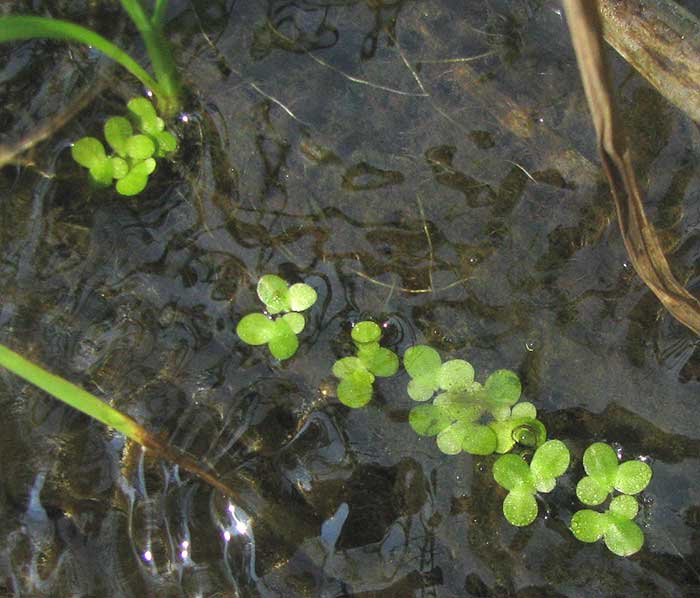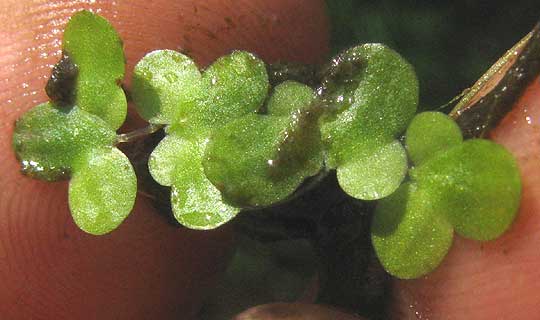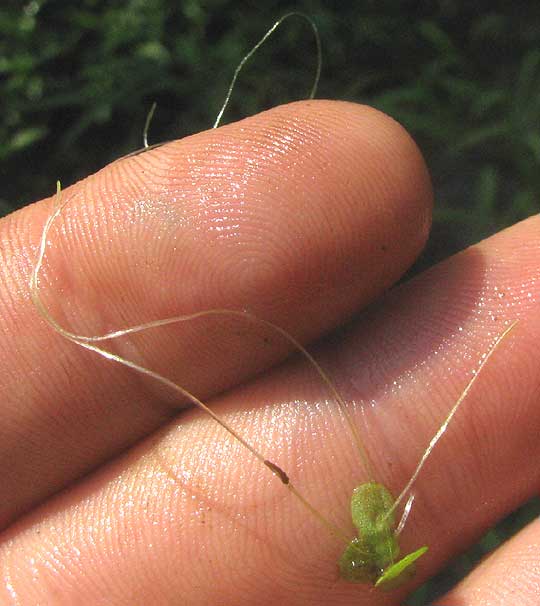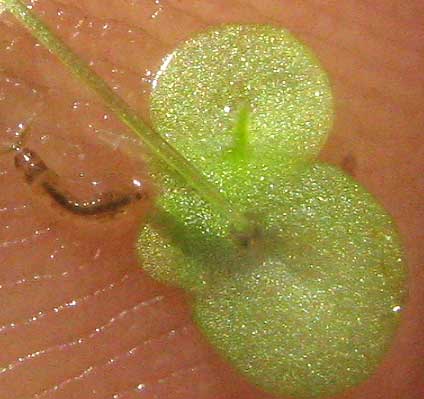Excerpts from Jim Conrad's
Naturalist Newsletter

from the the July 1, 2012 Newsletter issued from the woods of the Loess Hill Region a few miles east of Natchez, Mississippi, USA
A SMALLER DUCKWEED
Last week we looked at a relatively large, thumbnail-sized duckweed, Spirodela polyrrhiza, whose page is at http://www.backyardnature.net/n/h/duckwee2.htm. This week we have a much smaller species, with bodies, or fronds, averaging only about 5mm long (3/16ths inch). Last week's Spirodela formed a green carpet atop the water of a stagnant bottomland drainage ditch. This week's duckweeds constituted only about a dozen budding individuals in water that for months has been running across an abandoned dirt road next to a Baldcypress swamp in St. Catherine Creek National Wildlife Refuge just south of Natchez. The water running across the road issued from maybe a quarter of an acre
(0.1ha) of standing swamp water in which not a single duckweed of any species could be seen, so I figured that these few individuals on the road might be a special species. That's them above.
In the top half of that picture notice the white, threadlike items tangling in the water. Those are the duckweeds' roots, which are very much longer than last week's Spirodela, and longer than many, maybe most, duckweed species. A close-up of some fronds adhering to my fingertips is shown below:

In the top, right corner of that picture a duckweed frond presents itself edge-on. This is an important view because some of the species this might possibly be develop very substantial bulges on their fronds' undersurfaces -- they're "gibbous." You can see that this species is only slightly gibbous. Another view emphasizing the exceedingly long roots is below:

A close-up of some frond's undersurfaces showing only one root arising from each frond is below:

Without their rarely encountered flowers and fruits, duckweeds can be hard to identify. Fortunately the online but incomplete Flora of North America has a duckweed page -- a treatment of the genus Lemna -- so I was able to identify this species with a little, but not complete, certainty.
On the basis of this species' small size, long roots, its tops bearing no low protuberances, or "papillae," its bottom surfaces being almost flat instead of "gibbous," and there being little or no reddish color anyplace on the fronds, I'm calling this LEMNA MINOR, most commonly called Common Duckweed or Lesser Duckweed, and found nearly worldwide, except in the polar regions. During my fieldwork days in Kentucky, my impression was that Lemna minor was the most commonly encountered species up there.
As with last week's Spirodela, Lemna minor is an important food source for many kinds of fish and birds, especially ducks. The fronds are rich in protein and fats. Birds disperse the species when the fronds stick to their bodies just as they stick to my fingers in the pictures. I'll bet the tiny population there on the road was planted there this spring when a duck landed to see what was going on in the adjacent swamp.
In homeopathy, Lemna minor is regarded as working especially well on the nose's mucous membrane -- good for stopped-up and runny sinuses.